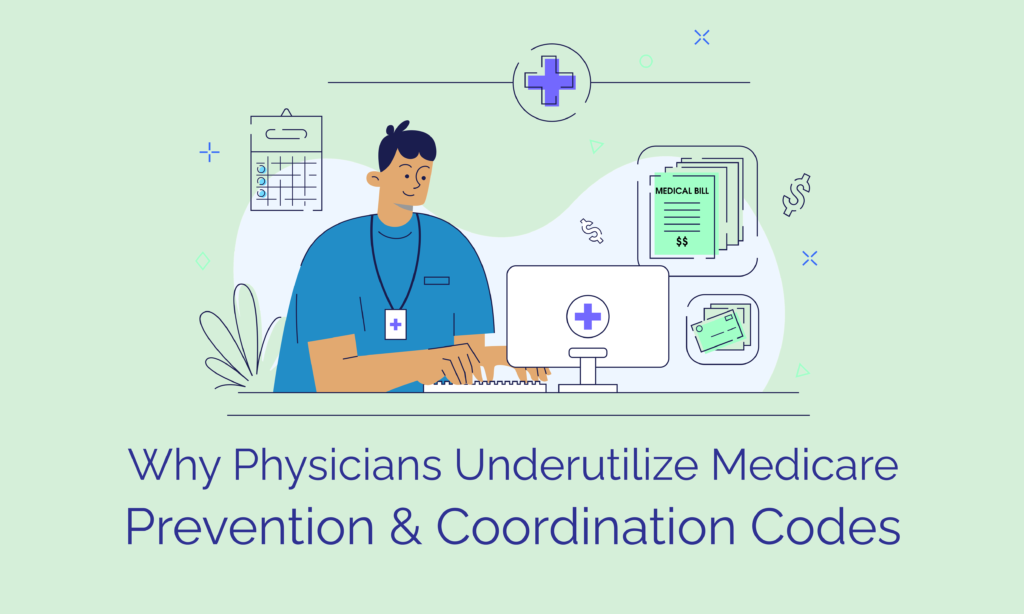Primary care plays a crucial part in the overall healthcare delivery system. Primary care providers (PCPs) are the first contact because they are often more affordable, convenient, and geographically accessible. The unique features of primary care have enabled physicians to provide highly beneficial services to patients because they capitalize on the benefits of timely prevention and the effectiveness of coordinated care.
Yet, a recent study published in the Annals of Medicine has discovered that physicians were not fully utilizing the prevention and coordination codes created by the Center for Medicare and Medicaid Services (CMS) to compensate them for all their non-face-to-face services. New revenue opportunities have opened to aid independent primary care physician practices, but there are barriers that hinder them from fully utilizing the rewards.
Measurements
Estimated Medicare revenue and frequency of use of 34 billing codes representing prevention and coordination services that PCPs may or may not bill for.
Primary Care Revenue Opportunities
What are these primary care revenue opportunities? Why are physicians not billing for it when they could?
How does Medicare support primary care? Chronic Care Management Medicare
Primary care is well-positioned to continue the care, establish a deeper relationship with patients, offer comprehensive treatment, and coordinate care with multiple providers. These are its core features, which are not supported under the traditional fee-for-service reimbursement system. Outpatient payments are limited to in-office visits, while out-of-office activities like treating patients over the phone or via electronic messaging, coordinating referrals to other providers for complex chronic care patients, and managing population health are not paid for.
Billing Codes For RPM, CCM, BHI, TCM, AWV
To ensure PCPs are justly compensated, CMS has continuously introduced new billing codes to the Medicare Physician Fee Schedule (MPFS). Over a 15-year period from 2005 to 2020, there are 34 new billing codes. Nineteen codes are for prevention, which includes services like the Annual Wellness Visits (AWV), screenings for depression and obesity as well as counseling. The remaining 15 are for coordinated care services like Behavioral Health integration (BHI), Chronic Care Management (CCM), and Transitional Care Management (TCM).
Medicare’s goal is to give physicians incentives by letting them bill separately for all their care activities. The truth is physicians have been caring for their patients so that they will be as healthy as possible and prevent them from having episodes that could lead to hospitalizations. The issue here is that many physicians are not billing for the care they provide. This is recently confirmed by a cross-sectional study conducted by three physician researchers from Brigham and Women’s Hospital in Boston last June 28. In this study, they looked into how physicians used the 34 Medicare billing codes as they provide primary care services to their patients.
What are the study findings and conclusions?
The study shows that physicians are not billing for their non-face-to-face services and missing out on earning tens of thousands of dollars in annual revenues that could help their practice stay independent and optimize their remote care.
Here are the other findings:
- About 9% to 100% of patients are eligible for a specific preventive service. Only 5% to about 61% of eligible patients receive it, and only 1% to about 36% of PCPs who provided the care billed for it.
- About 23% are eligible for TCM depending on the care coordination they require. Out of those, only 43% received the service and only 9% of PCPs billed for it.
- One physician alone potentially missed out on $50,000 in annual gross revenue because they fail to bill accurately for the preventive and coordinated care services they provided for all their eligible Medicare patients.
Physicians are clearly underutilizing the billing codes for almost all prevention and coordination services even though they are providing code-appropriate services to their eligible patients. The researchers conclude that the creation of additional billing codes for primary care activities in the MPFS has not been an effective strategy to aid primary care physicians.
So why are physicians not fully maximizing their billable services?
PCPs could substantially increase their annual revenues even if only 50% of their eligible Medicare patients receive preventive and coordinated care services. The following barriers hinder them from fully utilizing many of the Medicare incentives:
The complexity of navigating Medicare’s intricate requirements.
The billing codes are not as straightforward as they may seem. There are certain rules that physicians need to follow in order to bill for every service they render.
1. Eligibility and enrollments
Physicians are having a hard time explaining the services to their patients and enrolling them in coordinated care like TCM, CCM, and the more recent Remote Patient Monitoring (RPM). They need to secure their patient’s consent to participate and agree to the copay.
2. Documentation
CMS requires specific types of electronic health records (EHRs) in documenting the care services. For CCM, very detailed documentation is required for every minute of every phone call, electronic message, or email to the patient. For some physicians, adhering to all the guidelines deters them from participating because it adds to their workload and distracts them from caring for their patients.
3. Preparation of billing charges using the right CPT codes (remote patient monitoring CPT codes, chronic care management CPT codes)
For providers to be able to bill Medicare, they need to know every CPT code for different types of services. Not all physician practices have the capability or dedicated personnel to ensure compliance with all the existing guidelines. Failure to comply means the practice will not be able to receive any reimbursements.
The lack of technology, infrastructure, capabilities, and personnel to build their own virtual care services
To ensure practices get paid for their non-face-to-face services, certain technological requirements need to be in place. For instance, CMS specifically requires a certified EHR technology to fulfill the scope of service and billing requirements. Some practices that do not have the technology and infrastructure will not be able to utilize Medicare’s incentives or capitalize on its preventative benefits.
CCM or RPM program
Building a CCM or RPM program could entail a substantial capital investment that might not yield profits initially because the cost would be greater than the reimbursements earned. There will be additional costs in buying the devices, new software or technology, and in hiring new personnel or an IT team. Smaller facilities simply do not have the monetary resources to make such a huge financial commitment.
At present, CMS continues to give increasing reimbursement rates, especially for CCM to further push its adoption. Coupled with RPM, CCM has proven beneficial to patients with chronic conditions by keeping them engaged in their care and staying as healthy as possible. The multiple high touchpoints of CCM and the timely collection of patient data by RPM allow for a high quality of preventative care that produces positive health outcomes and also greatly reduces costs.
Reimbursement for Care Coordination Services
Many rural programs seek reimbursement opportunities to pay for care coordination services. Care coordination services can be billed to insurers by using Current Procedural Terminology (CPT) codes. Rural programs should identify which codes are covered and by which insurers, how much money is offered, and how to properly use them. Each insurer may react differently to the codes.
A number of CPT codes are available for transitional care management (TCM), complex chronic care coordination (CCC), and chronic care management (CCM). CMS provides specific guidelines for using these codes for care coordination.
99495 – Transitional care management with moderate medical decision complexity (face-to-face visit within 14 days of discharge)
99496 – Transitional care management services with high medical decision complexity (face-to-face visit within 7 days of discharge)
99490 – Chronic care management for a patient with multiple chronic conditions (at least 20 minutes spent per month with the patient).
99487 – Complex chronic care management for a patient with multiple chronic conditions (60 minutes spent per month with patient)
99489 – The cost of each additional 30 minutes of complex chronic care management time spent with a patient per month is 99489
How to get past the barriers?
Both the providers and the patients will benefit greatly from Medicare’s preventive and coordinated care programs through a better quality of care and new revenues for the practice. With 34 prevention and coordination codes, the opportunity is there but so are the barriers. The only lucrative and most practical solution is to outsource to a more experienced and dedicated provider.
Ascent Care Partners (ACP) is a virtual healthcare service provider offering turnkey CCM and RPM solutions to help primary care physicians realize a deserved revenue without increased overhead, no upfront cost, or risk. ACP offers a full service from patient enrollment and education to the preparation of billing charges to ensure physicians get paid for the care they provide.



